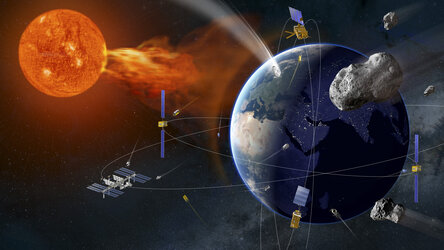How GENSO works
Note: The GENSO project is no longer operational.
A number of hardware items and software applications are necessary to realise GENSO. The technologies and frameworks being developed are detailed below.
Hardware and software: Authentication Servers (AUS)
These servers are equipped with GENSO software, which act as the central core of the network. They will not be directly accessible by the vast majority of users, instead being a control tool for network administrators.
In order to avoid a single point of failure there will be several authentication servers, connected to different internet backbones and synchronising with each other as necessary. All instances of the GSS and MCC (see below) will be equipped to contact their most local AUS by default, and then try the others in case of failure.
The set of authentication servers is known collectively as the Authentication Servers List (ASL). The tasks of the ASL are to validate the identity of instances of the GSS and MCC when they log on, maintain up-to-date lists of the attributes and statuses of all GENSO ground stations and spacecraft, distribute these lists to instances of the GSS and MCC as requested and necessary, and serve the project infrastructure with network data.
Software application: Ground Station Server (GSS)

The GSS application, when logged on to the Authentication Server, will allow participating GENSO ground stations to automatically track and establish downlink sessions with all compatible participating spacecraft – of course prioritising the owner’s craft if they have one.
The GSS application will also be used for upload of telecommands to compatible spacecraft (if allowed by the station owner, spacecraft operators and local law). Optional automated scheduling and booking negotiations with the MCC will be able to establish dedicated passes for particular missions.
The application will be fully configurable and transparent to the user, and all data will be able to be stored locally as well as transferred to spacecraft operators.
Software application: Mission Control Client (MCC)
When logged on to the Authentication Server, the MCC application will allow participating GENSO spacecraft to be automatically tracked by all compatible participating ground stations. Downloaded data will then be transferred to the MCC in real-time (or as bandwidth allows), regardless of the station location.
Capable ground stations which operators chose to trust can also be used for uplink to the spacecraft, and users will be able to request dedicated remote passes which the MCC will negotiate and book on their behalf with instances of the GSS. The application will be fully configurable and transparent to the user and all mission data will be stored locally.
Simple hardware requirements

GENSO is being designed to be as flexible as possible with regards to the hardware it can be used with. It is focused primarily on those sections of the VHF, UHF and S bands which are allocated for use by the radio amateur community.
There will be a ‘Hardware Abstraction Layer’ (HAL), consisting of a standardised language for ground station control and data flow. The GSS will be released with a large library of device drivers to interface to common radio amateur equipment, but it will also be possible for operators to add their own drivers if hardware is not supported. These can then be included in the library for the whole GENSO community.
Standard GENSO ground station
Although GENSO will be adaptable to most standard hardware, the team will also define an optimum ground station which will serve as a low-cost recommended hardware configuration ensuring an efficient high-return from GENSO utilising one, two, or all three of the main bands.
However there will be no requirement for operators to use this recommended hardware in order to participate in GENSO: only installation of the GSS and MCC software is needed.















 Germany
Germany
 Austria
Austria
 Belgium
Belgium
 Denmark
Denmark
 Spain
Spain
 Estonia
Estonia
 Finland
Finland
 France
France
 Greece
Greece
 Hungary
Hungary
 Ireland
Ireland
 Italy
Italy
 Luxembourg
Luxembourg
 Norway
Norway
 The Netherlands
The Netherlands
 Poland
Poland
 Portugal
Portugal
 Czechia
Czechia
 Romania
Romania
 United Kingdom
United Kingdom
 Slovenia
Slovenia
 Sweden
Sweden
 Switzerland
Switzerland
































